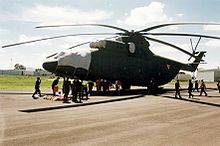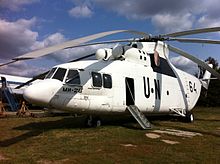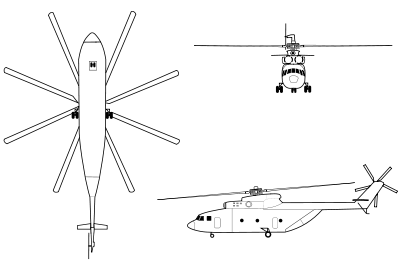- Mil Mi-26
-
Mi-26 Russian Air Force Mi-26 Role Heavy lift cargo helicopter National origin Soviet Union/Russia Manufacturer Mil Moscow Helicopter Plant First flight 14 December 1977 Introduction 1983 Status In service Primary users Russian Air Force
Aeroflot
Ukrainian Air Force
Indian Air ForceProduced 1980–present Number built 276 The Mil Mi-26 (Russian: Миль Ми-26, NATO reporting name: Halo) is a Soviet/Russian heavy transport helicopter. In service with civilian and military operators, it is the largest and most powerful helicopter ever to have gone into production.
Contents
Design and development
Following the incomplete development of the Mil V-12 in the early 1970s, work began on a new heavy-lift helicopter, designated "Project 90"[citation needed] and later allocated designation Mi-26. The new design was required to have an empty weight less than half its maximum takeoff weight.[1] The helicopter was designed by Marat Tishchenko, protégé of Mikhail Mil, founder of the experimental OKB Mil design bureau.[2]
The Mi-26 was designed as a heavy-lift helicopter for military and civil use, and was to replace earlier Mi-6 and Mi-12 heavy lift helicopters, with twice the cabin space and payload of the Mi-6, then the world's largest and fastest production helicopter. The primary purpose was to move military equipment like 13 metric ton (29,000 lb) amphibious armored personnel carriers, and mobile ballistic missiles, to remote locations after delivery by military transport planes such as the Antonov An-22 or Ilyushin Il-76.
The first Mi-26 flew on 14 December 1977. The first production aircraft (serial 01-01) was rolled out on 04 October 1980.[citation needed] One production aircraft was destroyed during pre-delivery single-engine emergency landing procedure testing, but there were no casualties.[citation needed] Development was completed in 1983, and the Mi-26 was in Soviet military and commercial service by 1985.[1]
The Mi-26 was the first factory-equipped helicopter with an eight-blade rotor. It is capable of flight in the event of power loss by one engine (depending on aircraft mission weight) thanks to an engine load sharing system. While it is only slightly heavier than the Mi-6, the Mi-26 can lift up to 20 metric tons (44,000 lb) - 8 tons more. It is the second largest and heaviest helicopter ever constructed, after the experimental V-12.
The Mi-26's unique main gearbox is relatively light but can absorb 19,725 shp, which was accomplished using a non-planetary, split-torque design. Because Mil's normal gearbox supplier said that such a gearbox couldn't be designed, the Mil Design Bureau designed the VR-26 transmission itself.[3]
In July 2010, a Russian-Chinese development of a successor type was announced.[4]
Operational history
Chernobyl accident
The Mi-26S was a disaster response version hastily developed after the Chernobyl nuclear accident.[5] and was used for radiation measurements and precision drops of insulating material to cover the damaged No. 4 reactor. It was also equipped with a deactivating liquid tank and underbelly spraying apparatus. The Mi-26S was operated in immediate proximity to the nuclear reactor, with a filter system and protective screens mounted in the cabin to protect the crew during delivery of construction materials to the most highly contaminated areas.[citation needed]
World Team skydiving
For three weeks in September 1996, the Russian military loaned four fully crewed Mi-26 helicopters and granted the use of its Anapa airbase to the World Team for its skydiving freefall formation world record attempt. The World Team was made up of top-tier skydivers from over 40 countries and led by Hollywood aerial stunt performer B. J. Worth. With the goal of setting a new 300-Way freefall formation record and using the high altitude and high capacity performance of the Mi-26, the World Team quickly flew 300 participants, plus aerial judges, photographers, and cinematographers up to 6,700 metres (22,000 ft), then simultaneously dropped them in a tight formation. The Mi-26 helicopter crews and equipment performed flawlessly in their first experience with close formation flying, and flew away with an assist in the new 297-Way world record set on September 27, 1996, just three shy of the objective.
Siberian Woolly Mammoth recovery
In October 1999, a Mi-26 was used to transport a 25-ton block of ice encasing a well-preserved, 23,000 year-old Woolly Mammoth from the Siberian tundra to a lab in Khatanga, Taymyr, where scientists hoped to study the find and perhaps attempt to clone it. The weight was reportedly so great that the Mi-26 had to be returned to the factory immediately thereafter to check for airframe and rotor warping caused by potential structural excesses.[2]
Afghanistan Chinook recovery
In Spring 2002, a civilian Mi-26 was leased to recover two U.S. Army MH-47E Chinook helicopters from a mountain in Afghanistan. The Chinooks, operated by the 160th Special Operations Aviation Regiment, had been employed in Operation Anaconda, an effort to drive al Qaeda and Taliban fighters out of the Shahi-Kot Valley and surrounding mountains. They ended up stranded on the slopes above Sirkhankel at altitudes of 2,600 metres (8,500 ft) and 3,100 metres (10,200 ft). While the second was too badly damaged to recover, the first was determined to be reparable and estimated to weigh 12,000 kilograms (26,000 lb) (with all fuel, rotors, and non-essential equipment removed), which exceeded the maximum CH-47 payload of 9,100 kilograms (20,000 lb) at an altitude of 2,600 metres (8,500 ft).
The Mi-26 was located through Skylink Aviation in Toronto, which had connections with a Russian company called Sportsflite that operated three civilian Mi-26 versions called "Heavycopters". One of the aircraft, doing construction and firefighting work in neighboring Tajikistan, was leased for $300,000; it lifted the Chinook with a hook and flew it to Kabul, then later to Bagram Air Force Base in Parvan, Afghanistan for shipment to Fort Campbell, Kentucky for repairs.[2] Six months later, a second U.S. Army CH-47 that had made a hard landing 100 miles (160 km) north of Bagram at an altitude of 1,200 metres (3,900 ft) was recovered by another Sportsflite-operated Mi-26 Heavycopter.[2]
Chechnya crash
Main article: 2002 Khankala Mi-26 crashOn 19 August 2002, Chechen separatists hit an overloaded Mi-26 with a surface to air missile, causing it to crash-land in a minefield and killing 127 of the people onboard.[6]
China, Wenchuan "Quake Lake" emergency
As a result of the magnitude 8.0 Sichuan earthquake on 12 May 2008, many rivers became blocked by giant landslides, resulting in the formation of so-called quake lakes: massive amounts of water pooling up at a very high rate behind the landslide-formed dams, which eventually crumble under the weight of the ever-increasing water mass,[7] and potentially endangering the lives of millions downstream. At least one Mi-26 belonging to a branch of China's civil aviation service was used to bring heavy earthmoving tractors to the most precarious of the quake-lakes at Tangjiashan mountain, located in extremely difficult terrain and accessible only by foot or air.[8]
Afghanistan helicopter downing
In July 2009, a Moldovan Mi-26 was shot down in Helmand province with the loss of six Ukrainian crew members. The aircraft, belonging to Pectox-Air aviation, was said to be on a humanitarian mission under NATO contract.[9]
Indian Air Force Mi-26 crash
On December 14, 2010, an Indian Air Force Mi-26 crashed seconds after taking off from Jammu Airport, injuring all 9 passengers. The aircraft fell from an altitude of about 50 feet (15 m), reportedly due to a technical malfunction.[10] But as per investigation report by Indian Institute of flight safety the crash happened due to improper fastening of the truck inside which led to an imbalance of the helicopter. The Mi-26 had been chartered by the Konkan Railway.[citation needed]
Variants
- V-29
- Prototype.
- Mi-26
- (NATO - 'Halo-A') Military cargo/freight transport version.
- Mi-26A
- Upgraded version with an upgraded flight/navigation system.
- Mi-26M
- Upgraded version of the Mi-26; designed for better performance.
- Mi-26MS
- Aeromedical evacuation version.
- Mi-26NEF-M
- Anti-submarine warfare version.
- Mi-26P
- Passenger transport version, with accommodation for 63 passengers.
- Mi-26PP
- Radio relay version.
- Mi-26PK
- Flying crane helicopter.
- Mi-26S
- Disaster relief version.
- Mi-26T
- Civil cargo/freight transport version.
- Mi-26TC
- Cargo transport version.
- Mi-26TM
- Flying crane helicopter.
- Mi-26TP
- Fire-fighting version.
- Mi-26TS
- Export version of the Mi-26T.
- Mi-26TZ
- Fuel tanker version.
- Mi-26T2
- Improved version of the Mi-26T equipped with BREO-26 airborne electronic system, allowing it to fly any time, day or night, under good and bad weather conditions.
- Mi-27
- Proposed airborne command post variant; two prototypes built.
Operators
Military Operators
- Belarusian Air Force has 10 aircraft in service as of January 2011.[11]
- Royal Cambodian Air Force has two Mi-26s in use as of January 2011.[11]
- Air Force of the Democratic Republic of the Congo has one Mi-26 in service as of January 2011.[11][12]
- Indian Air Force has four Mi-26s in use as of January 2011.[11]
- Kazakh Air and Air Defense Forces has four in service as of January 2011.[11]
- Mexican Air Force used to operate two units. Has one Mi-26 for sale.[13] It has one Mi-26 in inventory as of January 2011.[11]
- North Korean Air Force operates four aircraft as of January 2011.[11]
- Peruvian Army has one aircraft in service as of January 2011.[11]
- Russian Air Force operates 16 aircraft as of January 2011.[11]
- Russian Army
- Soviet Air Force and Soviet Army Aviation passed their aircraft to successor states.
- Ukrainian Air Force has 10 Mi-26s in use as of January 2011.[11]
- Uzbekistan's Air Forces operates one Mi-26 as of January 2011.[11]
- Venezuelan Air Force operates two aircraft as of November 2008.[12]
Civil operators
- Rent Helicopters operates one Mi-26s built in USSR.
- Skytech offers charters of Mi-26 and other USSR-built helicopters. They used to have 2 Mi-26s based at Charleroi-Gosselies EBCI airport.
- Airborne Energy Solutions operates one Mi-26 contracted from UTair Aviation
- China Flying Dragon Aviation operates two Mi-26T.
- Mi-26T "firebuster" 16 September 2000
- Aeroflot
- Avialift Vladivostok
- UTair Aviation
- Heliswiss International operates one Mi-26
Specifications (Mi-26)
Data from Jane's All The World's Aircraft 2003–2004[14]
General characteristics
- Crew: Five– 2 pilots, 1 navigator, 1 flight engineer, 1 flight technician
- Capacity:
- 90 troops or 60 stretchers
- 20,000 kg cargo (44,090 lb)
- Length: 40.025 m (131 ft 3¾ in) (rotors turning)
- Rotor diameter: 32.00 m (105 ft 0 in)
- Height: 8.145 m (26 ft 8¾ in)
- Disc area: 804.25 m2 (8,656.8 ft²)
- Empty weight: 28,200 kg (62,170 lb)
- Loaded weight: 49,600 kg (109,350 lb)
- Max takeoff weight: 56,000 kg (123,450 lb)
- Powerplant: 2 × Lotarev D-136 turboshafts, 8,500 kW (11,399 shp) each
Performance
- Maximum speed: 295 km/h (159 kt, 183 mph)
- Cruise speed: 255 km/h (137 kt, 158 mph)
- Range: 1,920 km (1,036 nmi, 1,190 mi) (with auxiliary tanks)
- Service ceiling: 4,600 m (15,100 ft)
See also
- Aircraft of comparable role, configuration and era
References
- Citations
- ^ a b Donald, David, ed. "Mil M-26". The Complete Encyclopedia of World Aircraft, p. 640. Barnes & Noble Books, 1997. ISBN 0-7607-0592-5.
- ^ a b c d Croft, John (July 2006). "We Haul It All". Air & Space 21 (2): 28–33. http://www.airspacemag.com/flight-today/milman.html.
- ^ Smirnov, G. "Multiple-Power-Path Nonplanetary Main Gearbox of the Mi-26 Heavy-Lift Transport Helicopter", Vertiflite March/April 1990, pp. 20-23
- ^ http://english.ruvr.ru/2010/07/22/13090628.html
- ^ [1] [2] Mil Moscow Helicopter Plant
- ^ BBC news article, 29 April 2004.
- ^ Swollen lake tops China's quake relief agenda, draining, evacuation side by side_English_Xinhua
- ^ Copters take off to large Sichuan "quake lake"
- ^ "Six Ukrainians die in Afghan chopper crash". Television New Zealand. Reuters. 15 July 2009. http://tvnz.co.nz/world-news/six-ukrainians-die-in-afghan-chopper-crash-2848179. Retrieved 25 October 2011.
- ^ The Times Of India. http://timesofindia.indiatimes.com/india/IAF-chopper-crashes-in-Jammu-9-injured/articleshow/7102861.cms.
- ^ a b c d e f g h i j k "World Military Aircraft Inventory". 2011 Aerospace. Aviation Week and Space Technology, January 2011.
- ^ a b "Directory: World Air Forces". Flight International, 11–17 November 2008.
- ^ Adquisiciones y Enajenaciones - 2011 Venta: HELICÓPTERO MI-26, MATRÍCULA1902
- ^ Jackson 2003, pp. 393–394.
- Bibliography
- Croft, John (July 2006). "We Haul It All". Air & Space 21 (2): 28–33.
- Gordon, Yefim, Komissarov, Dmitriy and Komissarov, Sergey, Mil's Heavylift Helicopters; Mi-6/Mi-10/V-12/Mi-26, Red Star Volume 22, Midland Counties Publications, 2005.
- Jackson, Paul (2003). Jane's All The World's Aircraft 2003–2004. Coulsdon, UK: Jane's Information Group. ISBN 0-7106-2537-5.
External links
- Rostov Helicopter Plant[dead link]
- Aviation.ru - Mi-26
- Aeronautics.Ru - Mi-26[dead link]
- Fas.org – Mi-26
- Walkaround Mi-26 Halo from Monino Museum, Russia
- Walkaround Mi-26 Halo from VAZ Technical Museum, Russia
- Walkaround Мi-26 from Kolomna, Russia
Mil aircraft Lists relating to aviation General Aircraft (manufacturers) · Aircraft engines (manufacturers) · Airlines (defunct) · Airports · Civil authorities · Museums · Registration prefixes · Rotorcraft (manufacturers) · TimelineMilitary Accidents/incidents Records Categories:- Military helicopters
- Soviet military transport aircraft 1970–1979
- Mil aircraft
- Soviet helicopters 1970–1979
Wikimedia Foundation. 2010.












